With Tinker, Tenor, Doctor, Spy, Star Trek: Voyager is back to business as usual.
The first episode produced after the departure of Ronald D. Moore, Tinker, Tenor, Doctor, Spy is in many ways an archetypal Voyager story. Equinox, Part II was the second part of a season-bridging two-parter; Survival Instinct was a dark fable about consequences and trauma that was the last script credited to on the franchise’s most beloved writers; Barge of the Dead was a surreal and ambiguous adventure into the Klingon afterlife. As such, it is strange that an episode that opens with a playful operatic number about Tuvok’s pon farr should mark a return to normality.

“My Delta Quadrant TripAdvisor review is going to be scathing!”
Nevertheless, Tinker, Tenor, Doctor, Spy is a very neat standalone episode with a clear beginning, middle and end. It is built around the character of the EMH, leaning into actor Robert Picardo’s comedic chops. It is very much in keeping with Voyager‘s recurring fascination with the notion of fractured reality as expressed in Projections or Deadlock or Retrospect, and also in using a technologically-derived character to literalise the process of a psychological breakdown as in Darkling, Infinite Regress or Latent Image.
Tinker, Tenor, Doctor, Spy story has its own themes and ideas, and everything is neatly resolved by the closing credits. It is a reminder that the serialisation that defined Star Trek: Deep Space Nine would remain the exception, rather than the rule, that it would not be inherited by its surviving sibling. Tinker, Tenor, Doctor, Spy could almost be watched at any point in the show’s run, although the involvement of Seven of Nine would suggest the final four seasons. Nevertheless, the episode never feels particularly tethered to this moment or this season.

Fantasy figure.
However, Tinker, Tenor, Doctor, Spy is also an example of how this approach can work. Voyager received (and deserves) a lot of criticism for failing to evolve with the times, for allowing the Star Trek franchise to fall behind the curve of contemporary television science fiction. However, the series was occasionally capable of demonstrating the merits of standalone episodes, the appeal of being able to transition from one self-contained story to another twenty-six times in the course of a season.
Of course, the issue was that a lot of Voyager episodes were bland and forgettable. However, every once in a while the series would produce a self-contained episode that demonstrated the appeal of this narrative model; Remember, Distant Origin, Concerning Flight, Living Witness, Someone to Watch Over Me. Appropriately enough, coming after another turbulent period in the history of the show, Tinker, Tenor, Doctor, Spy is another fine example of this capacity to construct satisfying and engaging stand-alone narratives.

Painting a pretty picture.
It is impossible to imagine Tinker, Tenor, Doctor, Spy working without the EMH (and thus Robert Picardo) at its core. This makes it somewhat ironic that the original pitch for the episode was to centre it around Neelix. As producer Brannon Braga explained to Cinefantastique:
We wanted to do The Secret Life of Walter Mitty with Neelix. We realized that it would probably be a better show for the Doctor. A hologram having daydreams, particularly a character like the Doctor, might be a whole lot more fun. In that case, you could actually go onto the holodeck and see his daydreams, which was particularly humiliating for the Doctor. Joe Menosky just nailed that script. Mike Westmore came through for us. Those were the best aliens this year. That’s my favourite one of the year.
Indeed, the original title of the episode was “The Secret Life of Neelix”, to the point that it was listed in pre-release publicity as such. It is interesting to wonder how far the episode made it into development before the decision to change the focal character was made.
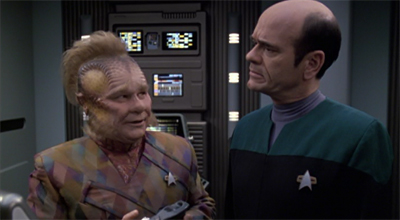
Taking his Neelix.
This shift in focus is undoubtedly a good thing. Ethan Phillips is perhaps the most underrated actors in the Voyager ensemble. It is revealing that Ethan Phillips and Robert Picardo are the two Voyager cast members to have enjoyed small but memorable roles in Coen Brothers films – Phillips in Inside Llewyn Davis and Robert Picardo in Hail, Caesar! Phillips has consistently demonstrated an ability to carry weighty material, from Jetrel to Fair Trade to Mortal Coil. He is also a gifted comedic performer, as Someone to Watch Over Me demonstrated.
However, the writing for the character of Neelix has never been consistent. The character has never been allowed to grow and develop in a way that plays to the strengths of Ethan Phillips as a performer. As with the flaws in the characterisation of Chakotay, this is largely down to poor decisions made early in the run. Neelix was initially characterised as a possessive and jealous boyfriend whose behaviour was at best emotionally manipulative and at worst abusive; Phage, Elogium, Twisted, Parturition. He was also at the centre of disasters like Investigations.

Handing over responsibility.
It is easy to imagine Neelix living a rich and vivid fantasy life. Indeed, it is Neelix who extols the virtues of daydreaming to the EMH. “On Talaxia, we have a saying,” Neelix explains, “the dream dreams the dreamer.” However, the concept of The Secret Life of Walter Mitty seems much better suited to the EMH in a number of different ways. As talented (and deserving of a high-quality spotlight episode) as Ethan Phillips might be, it is simply impossible to imagine The Secret Life of Neelix working anywhere nearly as effectively as Tinker, Tenor, Doctor, Spy.
There are several reasons for this. Most obviously, Voyager has done a much better job at balancing the egocentrism of the EMH than that of Neelix; Neelix tended to express his insecurity by bullying Kes, while the jerkish EMH was allowed moments of sympathy in early episodes like Eye of the Needle. The EMH has a poor bedside manner, as the show has repeatedly suggested, but this is somewhat excused by the fact that he is literally a computer programme rather than a person. The EMH is journeying towards the sort of self-determination that other characters take for granted.
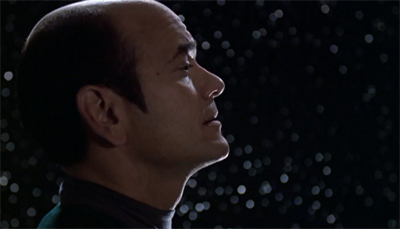
Holo ambition.
Building on that idea, there is an innocence to the EMH that is sorely lacking in Neelix. Voyager has effectively established that the EMH has none of the skills that human beings have at navigating complicated emotional or social situations. The EMH went on his first “away mission” in Heroes and Demons, and only gained the capacity to leave Sickbay and the holodeck in Future’s End, Part I and Future’s End, Part II. The audience has watched the character wrestle with choosing a name, and even went on his first date in Lifesigns.
Indeed, Tinker, Tenor, Doctor, Spy seems perfectly calibrated to Picardo’s comedic and dramatic strengths, playing on the actor’s ability to convey both arrogance and vulnerability, a character with an uncontrollable ego but also incredibly sensitive to what his colleagues and acquaintances think about him. The audience can laugh at the absurdity of the EMH’s inflated self-regard, but understand the insecurity lurking underneath. As such, even sequences in which the EMH imagines his female coworkers fighting over him (or posing naked for him) never feel as creepy as they probably should.

“Well, looks like the decision to have the EMH’s perspective restricted to PG-13 is still working at any rate.”
Tinker, Tenor, Doctor, Spy cleverly shifts the audience’s sympathies to the EMH by structuring the story as to hinge on repeated violations of his privacy – first by the voyeuristic Phlox and subsequently by the Voyager crew. “I’ve been exposed, humiliated,” the EMH reflects once his programme is stabilised. “Turned inside out for all the world to see.” Who cannot empathise with the EMH’s humiliation and embarrassment at having his fantasies exposed to the world? Who wouldn’t cringe if their every idle and passing daydream were laid bare for their friends and colleagues to examine?
There is perhaps something very timely in the exposure at the heart of Tinker, Tenor, Doctor, Spy, with the idea that what should be personal and private can be exposed through the world in this era of information technology and cloud computing. The EMH’s fantasies are particularly prone to such exposure because he is a computer programme himself, but Tinker, Tenor, Doctor, Spy plays very well in the era of leaked photos and hacked accounts, in the notion that privacy as a concept does not really exist any more and everybody’s life is now stored on a server that can be laid bare for public consumption.
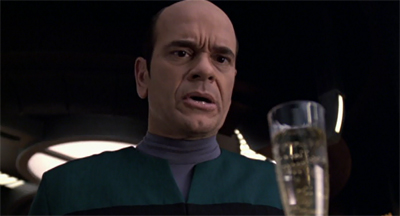
A champagne in the behind.
In a world where people’s digital and social media footprint is large enough that there is at least the remote possibility of modelling an artificial intelligence from them, the virtual voyeurism of Tinker, Tenor, Doctor, Spy no longer seems as fantastical as it would have on original broadcast. Author Seth Stephens-Davidowitz has argued that even something as innocuous as the Google search function becomes a window into the user’s psyche:
“I think there’s something very comforting about that little white box that people feel very comfortable telling things that they may not tell anybody else about: Their sexual interests, their health problems, their insecurities. And using this anonymous aggregate data we can learn a lot more about people than we’ve really ever known,” he said.
Modelling search data and history, companies like Google are able to model complex and accurate ideas of who people fundamentally are. Massive data hacks suggest that this sort of information is rarely entirely secure. In the twenty-first century, people have repeatedly discovered that their personal lives are not so personal; private photos are rendered public, attempts at infidelity exposed to the world. More than four billion personal data records were stolen in 2016.
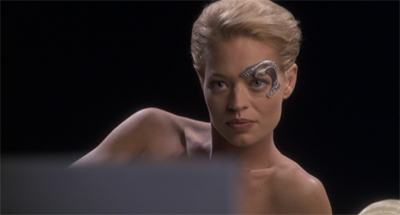
A sketchy proposition.
By chance, Tinker, Tenor, Doctor, Spy is more relevant than it was on initial broadcast. This is largely down to the use of the EMH as a focal character. In keeping with Voyager‘s approach to its technologically-driven characters like the EMH and Seven of Nine, Tinker, Tenor, Doctor, Spy serves to literalise the character’s psychosis through the wonders of Star Trek technology. Voyager frequently has these characters process psychological traumas, using the franchise trappings in order to provide a framework where these issues.
In Projections, a freak accident put the EMH through the equivalent of a psychological breakdown. In The Swarm, excessive use led to programme degradation that very closely mirrored the deterioration of mental facilities that often comes with age. In Darkling, the series allowed the character a Jekyl-and-Hyde story explained by tinkering with his programme. Seven of Nine had her own psychological break in One, rationalised through techno-babble about some interference with her implants. In Infinite Regress, a strange alien device gave her multiple personality disorder.

The heart of the matter.
Here, the EMH gets to literalise the process of daydreaming by literally coding it into his programme. This means that what might originally have been a concept too daring and abstract for a series as conservative as Voyager could be folded gently back into the narrative. It also allows the characters to literally wander into his daydreams, as the Enterprise crew did with Data’s dreams in Phantasms. Sure, the concept is a direct lift, but it is a small enough part of Tinker, Tenor, Doctor, Spy that it feels more like canny recycling than outright theft.
The EMH’s holomatrix provides a framework for Voyager to indulge in one of the oldest Star Trek pastimes, and one of the inevitabilities of a twenty-six episode season. It is a loose adaptation of a piece of classic literature, just as Obsession and Bliss (and countless others) played on Moby Dick or Someone to Watch Over Me built on Pygmalion. As its original title suggested, and as Brannon Braga acknowledged, Tinker, Tenor, Doctor, Spy is very much a riff upon the concept of The Secret Life of Walter Mitty, the classic short story written by James Thurber.
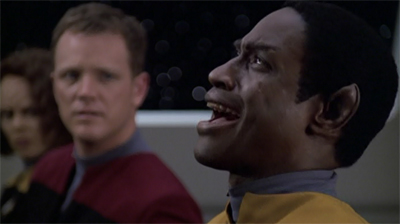
Tuvok’s really into it.
The most fun I’ve had in shooting the entire series is [last season’s] episode Tinker, Tenor, Doctor, Spy. It was great fun and one of our most successful outings at humor on our show. Basically, it’s a retelling of The Secret Life of Walter Mitty. The Doctor has attempted to alter his program so he has the capacity to daydream. In his daydreams, he is consistently the hero who saves the day–regardless of the circumstances. And of course all of the women are in love with him and need his help.
The Secret Life of Walter Mitty is a classic of American literature, one that resonates with a lot of people. Who hasn’t dreamed of an escape from the mundane?
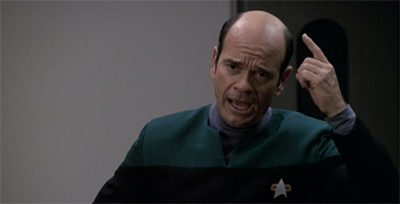
“I’m actually pointing at the ship’s databanks. Not my head. Because my head is just a projection, and that would be weird.”
In some ways, the decision to adapt The Secret Life of Walter Mitty is very much in keeping with the general tone and aesthetic of Voyager. More than any other Star Trek series, Voyager is firmly rooted in the aesthetic and trappings of the mid-twentieth century; a strong nostalgia that seems to pave the way for the various prequels that would follow. Voyager is particularly invested in the idea of the thirties, forties and fifties as the root of the Star Trek franchise, in both a literal and metaphorical sense.
This interest is reflected in a number of different ways: the retro western aesthetic established by Caretaker; the twentieth-century trappings of Paris’ holoprogrammes in episodes like Vis á Vis, Night and Repression; the Second World War setting in The Killing Game, Part I and The Killing Game, Part II; the recurring fascination with the atomic bomb in Jetrel, The Omega Directive and Warhead; the use of space Nazis in stories like Resistance and Counterpoint; even the retro b-movie aesthetic of stories like Threshold and Macrocosm.
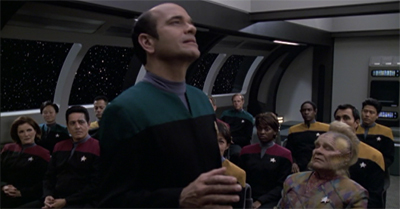
With a spring in his step and a song in his matrix…
The Secret Life of Walter Mitty is perhaps a part of the this mid-twentieth century aesthetic, capturing a snapshot of the American character at the dawn of what would be known as “the American Century.” (The short story was first published in 1939.) Critic Charles S. Holmes argued that James Thurber was one of the great American creative forces of the mid-twentieth century:
It is by now a truism to say that James Thurber is the greatest American humourist since Mark Twain. His imagination was tuned to the discords of the twentieth century with preternatural accuracy. In his stories, essays, and drawings we find comic images of our public and private apprehensions: the character of Walter Mitty, as Time magazine once said – stands as an archetype of modern man.
It should be noted that The Secret Life of Walter Mitty was written on the cusp of the moment when the United States would emerge as one of the world’s two most powerful political entities, but also at a time when the country’s cultural reach was expanding and cementing. Through Hollywood and feature films, the cultural imagination of the United States would become the cultural imaginings of the larger world.

Sampling.
This lends The Secret Life of Walter Mitty a decidedly postmodern quality. After all, it could be argued that the second half of the twentieth century (and beyond) marked a point at which the imagination truly became a cultural force rather than a personal diversion. Through film and television, it was possible for people to not just create and inhabit fantasy worlds, but to package those fantasy worlds and share them with larger audiences. People were no longer just living their own fantasy lives; they were cohabiting.
Tinker, Tenor, Doctor, Spy literalises this idea of a shared fantasy in a number of different ways, with Janeway literally walking through the EMH’s imaginings on the holodeck and Phlox watching from a distance. Tinker, Tenor, Doctor, Spy makes it clear that the EMH’s daydreams are not merely his own, that they exist outside of himself and have some bearing on reality itself. Perhaps Neelix is right; the dream exists beyond the dreamer. The fantasy is no longer individual, it is collective. It is no longer an idle distraction, but a boundary-blurring threat to reality itself.
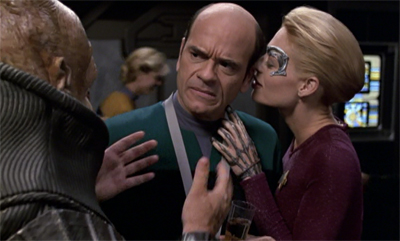
State of Phlox.
In some ways, the explosion of conspiracy theory in the second half of the twentieth century is just an expression of this sharing of fantasy; of an elaborately constructed alternate reality which serves as a haven for groups rather than individuals. Voyager has been very interested in this as a recurring theme, in the way that cultures and societies (and individuals) structure events into cohesive narratives that suit their political and social needs. Stories like Remember, Distant Origin and The Voyager Conspiracy suggest the danger of obscuring memory with fantasy.
Of course, there are other (more benign) examples of shared fantasies. Star Trek is arguably an example of this; a utopian future in which mankind has put aside its differences and journeyed out into the stars for the betterment of the universe itself. There is of a daydream about Star Trek, the casualness with which the characters (and the audience) accept the impossible, not to mention the way in which the series unfolds at once at a remove from the modern world and also a reflection of it. At its best, Star Trek is a franchise that appeals to dreamers.

Seven’s HTML coding is the best. She even changed the font colour.
As Duncan and Michèle Barrett note in Star Trek: The Human Frontier, there is a reflexive and postmodernist quality to Tinker, Tenor, Doctor, Spy that is very much in keeping with Voyager‘s approach to storytelling:
The sixth-season Voyager episode Tinker, Tenor, Doctor, Spy is a perfect example of both the ludic post-modern quality of late 1990s Star Trek and the show’s obsession with its own history. In this distinctly silly story, the holographic Doctor is developing the capacity to daydream. Since he is, in many respects, an insufferable egotist, his fantasies predictably tend to cast him in a heroic light. But a crisis ensues when some aliens manage to hack into the Doctor’s imaginary scenarios and take them for the reality of life on Voyager, which they promptly plan to attack. The only solution is for the Doctor to act out his fantasy for ‘real’ – casting himself as the ‘Emergency Command Hologram’ who has taken charge of Voyager.
Even the EMH remarks upon the reflexive twist of the episode’s final arc, as Phlox comes to him for help. “Voyager is about to be attacked,” Phlox insists. “Of course it is,” the EMH sighs. “Unless the valiant Doctor swings into action, right?” He reflects, “A common theme in all my fantasies.”

The threat at hand.
At the end of Tinker, Tenor, Doctor, Spy, those fantasies becomes a reality. Much of Tinker, Tenor, Doctor, Spy is built on blurring the lines between fantasy and reality, with the EMH malfunctioning once his perception of reality is distorted so that it moves out of line with the world outside himself. However, the ending of Tinker, Tenor, Doctor, Spy suggests that reality might just be as malleable as the EMH’s perception of it; the climax of the episode finds the EMH forced to live his fantasy for real, blurring the line between fantasy and reality by bending reality to be closer to fantasy.
Voyager has always been interested in constructing self-aware and reflexive studies of reality, reflecting the interests of both showrunner Brannon Braga and writer Joe Menosky. Voyager frequently constructs narratives in which the audience is asked to peel back layers of reality within the framework of the story. Indeed, there is an argument to be made that this is reflected in something as simple as making the EMH one of the primary characters on the show. There are questions as to whether the EMH is a “real” person in any way the audience could understand, beyond similar debates about Data or Odo.
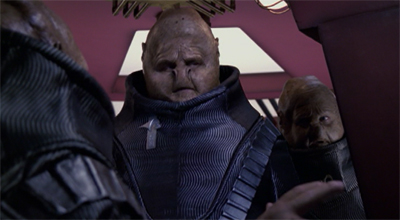
How do they manage?
In particular, Joe Menosky’s work on Voyager is very explicitly interested in the idea of Star Trek as a piece of twentieth-century pop mythology. Menosky’s scripts tend to focus on the idea of Voyager as something of a legend in the Delta Quadrant, a source of myth and rumour and speculation. The crew are imagined as prophets at the end of False Profits, distorted by the historical record in Living Witness and become a source of mythology in Muse. There is a sense of Voyager as a story rather than as a ship.
Tinker, Tenor, Doctor, Spy fits very much within this tradition. The episode is in some ways a loving ode to Star Trek fandom, as best demonstrated by the character of Phlox. The Hierarchy are a fascinating creation, and one of the most underrated recurring aliens on Voyager. They are transparently a single word concept expanded to an entire species – like “hunters” to the Hirogen or “polluters” to the Malon. However, the Hierarchy are not built around a “fun” or “exciting” concept. They are not a society of warriors or traders or death worshippers. They are a sprawling bureaucracy.

“Just one question: what is a Son…tar…an?”
In some ways, this is a fun twist on the Star Trek franchise’s tendency to reduce entire cultures to metaphors for abstract concepts, picking perhaps the least satisfying abstract concept imaginable. It is hard to imagine a compelling or satisfying story build around a race of middle-managers. However, the Hierarchy work perfectly in the context of Tinker, Tenor, Doctor, Spy, and not just because it is a comedy episode with (slightly) lower stakes than usual. The introduction of the Hierarchy allows Tinker, Tenor, Doctor, Spy to parallel the EMH with Phlox.
Tinker, Tenor, Doctor, Spy suggests that the EMH dreams of a more exciting life because he spends much of his time trapped inside Sickbay without being used to his full potential. “Captain, this ship needs its Doctor,” Chakotay reflects at one point. “He should focus on what he was programmed for.” Janeway responds, “I think we’ve underestimated him because of our own human limitations. His full potential’s unknown, Chakotay.” While many people can empathise with this situation, feeling undervalued or under-utilised, by his nature, the EMH is still beyond human frame of reference.
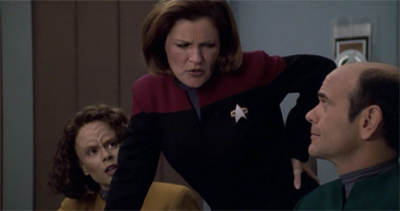
The spine of the episode.
In contrast, Phlox provides a much more relatable sense of being trapped in an unfulfilling life. Phlox has a mundane job, reporting to a manager who does little to encourage his creativity. Phlox spends most of his day in the deep space equivalent of a cubical, processing data. Occasionally he sends some report or recommendation to his supervisor, who then sends it down the line to some centralised authority that reaches a decision in the abstract. There is something surprisingly human in Phlox’s mundane existence, something much more relatable than the threat of the Hirogen or the Malon.
As the EMH, fantasy provides an escape for Phlox. However, Phlox does not escape into his own fantasies; Phlox escapes into the daydreams of the EMH. While Janeway can use the holodeck to literalise the EMH’s fantasies and to walk among his waking dreams, Phlox is instead consigned to watching these fantasies displayed on a two-dimensional monitor. In effect, Tinker, Tenor, Doctor, Spy suggests that Phlox spends his days watching Star Trek as a means to retreat from his soul-destroying reality.
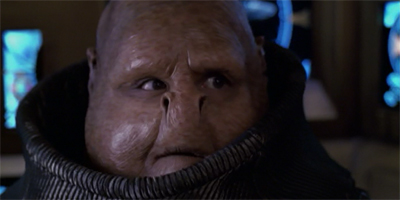
Totally Phloxed.
Tinker, Tenor, Doctor, Spy invites the audience to compare Phlox’s observation of the EMH as an equivalent to watching a television series. “This is my observation post,” he explains. “I have a single function. But the Doctor does much more than just practice medicine. He has access to the entire ship, and he seems to be an expert on everything. In fact, the Captain just gave him authorisation to command the bridge! It was a very exciting moment.” There is an element of voyeurism to this, as if Phlox if living vicariously through his subject.
In some ways, Phlox could be seen as a twenty-fourth century television recapper – watching hours of television and reporting back on it for his employer. Again, there is something almost prescient in the way that Phlox seems to prefigure a culture of recapping rather than reviewing television; a yearning for instant reactions ahead of considered criticism. Phlox processes the images relayed from the EMH without any critical analysis or thought, and so is taken in by his absurd fantasies. (He cannot see the holes in logic, even when his supervisor points out how unlikely it all is.)
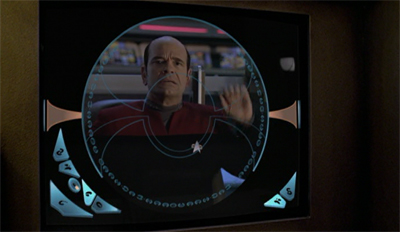
Getting paid to watch Star Trek.
That’s the dream.
Appropriately enough, Phlox deduces that something is wrong with the information he has been receiving using the language of television. He starts noticing the cuts, the edits, the scene transitions that are present in a work of entertainment, but absent from real life. “I’ve made a terrible mistake,” he confesses. “The Doctor was appearing in a different location every few seconds. It didn’t seem possible, so I investigated a little further and I haven’t been monitoring his perceptions, I’ve been watching his dreams, or his, his imaginings. I’m not sure which. But none of this is real.”
The climax of the episode suggests that Phlox is something of a fan. When the EMH asks why he should care about Phlox, the alien explains, “If they learn of my error, I’ll lose my livelihood.” However, Phlox suggests a deeper investment in the survival of Voyager. “I also care about what happens to you,” he elaborates. “I feel like I’ve got to know you over the past few days.” He continues, “I know how your mind works, what your hopes are. You created all these possibilities. My species, we’re very different. Our thinking is confined but, I can’t help but admire you.”

When they find out what the EMH has done to his programme, he’ll be toast.
This sentiment should be familiar to any Star Trek fan. The franchise has a long history of inspiring its audience towards greater things. Whoopi Goldberg was famously inspired by seeing Uhura on the original Star Trek, a black woman who wasn’t a maid. Similarly, Star Trek inspired Mae Jemison to become an astronaut. This is the power of dream and imagination, and the freedom that it can offer people to escape lives that might otherwise waste their potential. Tinker, Tenor, Doctor, Spy captures that power and romantically tethers it to Star Trek fandom.
Of course, this conscious embrace of Star Trek fandom came at a very crucial point in Voyager‘s production history. After all, certain sections of fandom seemed to be turning on the franchise, perhaps smelling blood in the water. The acrimonious departure of Ronald D. Moore earlier in the sixth season had ignited debates within fandom, perhaps bringing long-simmering tensions to the surface. Indeed, with the end of Deep Space Nine, the sixth season of Voyager marked the point at which it seem that Star Trek fandom had become openly antagonistic towards the franchise production team.

“I’m a shipper. In that I am a fan who live on a ship.”
With this in mind, Tinker, Tenor, Doctor, Spy presents Phlox as something approaching an idealised and romanticised fan. Phlox is emotionally invested in the EMH (and Voyager) and wants them to succeed. He is not bitter or angry about their failings, not vindictive in his criticism. There is something very heartwarming in Phlox’s earnestness, in the pride that the character takes in his small accomplishments and the sincerity of his affection for these people that he only watches through his television.
The climax of Tinker, Tenor, Doctor, Spy reinforces the episode’s reflexive quality. Locked in a stand-off with the Hierarchy, the EMH is forced to make a desperate gambit in order to save his ship. He falls back on “the photonic cannon”, a weapon plucked directly from his daydreams. It is a bluff. “My sensors are showing no activation sequence,” reflects the supervisor. The EMH responds, “Of course not. The photonic cannon is impervious to sensors.” It is a high-stakes ruse, one with potentially disastrous consequences, but it works because the EMH finds inspiration in his daydreams.

What (corbo)mite have been.
However, this climax is also the plot of The Corbomite Manoeuvre, an episode of Star Trek in which Kirk finds himself facing off against the First Federation. Thinking fast, Kirk invents the a fictional substance called corbomite, claiming it can easily overwhelm the threatening vessel. The ruse works. Although the EMH lacks some of Kirk’s trademark swagger, the basic resolution is the same: the ship finds itself squaring off against a tactically superior foe, but survives through the application of a canny bluff.
As such, Tinker, Tenor, Doctor, Spy might be seen to be taking Voyager back to its Star Trek roots, and affording Phlox the opportunity to live through one of the franchise’s earliest adventures. The Corbomite Manoeuvre was the tenth episode of Star Trek to be broadcast, but only the third episode produced. In fact, The Corbomite Manoeuvre is notable as the first regular episode of Star Trek to be filmed, the first episode to go into production after the two pilots, The Cage and Where No Man Has Gone Before. Tinker, Tenor, Doctor, Spy celebrates Star Trek by affectionately restaging it.
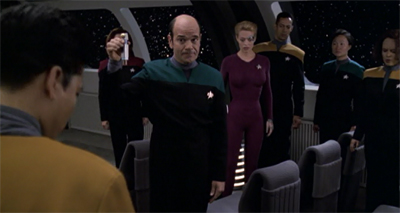
Dropping the hypospray.
Tinker, Tenor, Doctor, Spy is a delightful instalment, and a reminder that Voyager‘s approach to storytelling was not inherently bad; the series still refused to commit to long-form storytelling and to explore continuity. However, it is hard to complain when the resulting standalone episodes are this engaging or enticing. Tinker, Tenor, Doctor, Spy is an episode that celebrates those who dare to dream, which makes it a perfect fit for Star Trek.
Filed under: Voyager | Tagged: bureaucracy, dreams, emh, fantasy, imagination, star trek, star trek: voyager, the hierarchy, the secret life of walte rmitty |




















So it’s come to this. A Titanic parody.
I actually like the scene, not so much for the Doctor’s perversions being witnessed by the crew, but Seven’s blase attitude to being seen naked. This comes up again with Q’s son, and in one of the interviews on youtube, Jeri Ryan mentioned that the catsuit actually became an asset, since she didn’t want Seven to look too butch. It fits with the Borg continuity (even if it still doesn’t explain why she continues to wear a catsuit after her skin has grown back), and it shows Ryan is an actor of no small talent. Saddled with a bad costume and working environment, she incorporated both into her character and strengthened the performance, which probably drove her co-stars mad.
I also like the Hierarchy. As with the finest VOY episodes, it takes something which didn’t quite come off in TNG, in this case Ferengi pirates, and tweaks it to make it more interesting. They are visually based on the Sontaras, but lack any of heir machismo, and the villain of the week is simply trying to save his job. He won’t be thrown out the airlock if he fails, and he’s not trying to physically harm anyone, he’s just a worker drone who bit off ore than he can chew.
The Heirarchy are one of my favourite Voyager aliens. And, sadly, they fit with the tone of the sixth season. “Just doing a job, doing it on schedule, cashing a paycheck.”
Along with ‘Someone to Watch Over Me’ this is perhaps my favorite VOY episode. I really emphasized with the core story of how both the EMH and Phlox are trying to escape their realities, and how they used their dreams to win in the end.
I’ve never read/seen ‘Walter Mitty’ so of course the story came across as new to me when I first saw it 🙂
As a sidenote, I feel like VOY is so strait-laced and filled with techno-babble in most episodes that the actors really do some of their best work in the comedic ones. Aside from TOS I think VOY really has many of the best comedy episodes in ST, thanks mainly to Jeri Ryan and Robert Picardo’s terrific performances.
I mean, I don’t mind “Star Trek does [show/film/book/play]” stories. After all, there are seven hundred episodes of Star Trek. I’m not sure there are that many unique or distinct stories. The key is to do something interesting with the premise. Which, incidentally, I think Tinker, Tenor, Doctor, Spy and Someone to Watch Over Me both do.
I have found no evidence of this anywhere online but…
In the opening scene, a star field is shown before the doctor appears. The spaces between these stars resemble a word, perhaps “doctor” or “hero”. Has anyone else noticed this?
//s.imgur.com/min/embed.js
sorry – not sure of the protocol to share an image
Not sure… Are you?
Not as funny as I remembered it, but there was a lot to like here, it just flowed very well. And I did find the Hierarchy to be an interesting addition to the Delta Quadrant-species. I completely forgot that they were not one of Star Trek’s usual “one hit wonders” (aka alien of the week).
Interesting that the Hierarchy accessed the Doc’s dreams from a third-person perspective. I did wonder afterwards if it was just a production mistake or if there is some truth to ourselves dreaming not from a first person-perspective. Not sure….
I suspect it’s also just a nice way to get meta, to have a Voyager episode about the aliens watching Voyager.
Rather aliens watching Robert Picardo. Not a bad choice to stop zapping.
The Hierarchy are fun, and an example of more innovative world building. Voyager has a dearth of aliens who aren’t just despots/pirates/raiders/”bad guys”. It’s nice to see a race with some sort of empathetic background. Sadly, this being Voyager, this is almost all we get.
I think any male watching this episode will get a little thrill seeing Seven give out kisses. Much like Phlox tunes in to watch the Doctor’s fantasies, we tune in and place ourselves in his position. This really is a fan-service, PG-(13?) style.
It’s been quite a while since I watched this one, but I recall how the Hierarchy were aware of the Borg and respected them, bit in an abstract way that didn’t suggest the Borg were a cataclysmic threat. As with the Vorta, the Hierarchy easily disable Voyager, while the Borg can never seem to inflict much of any harm on the ship. Voyager and the Hierarchy have a kinship really, given how much both love order above all else.